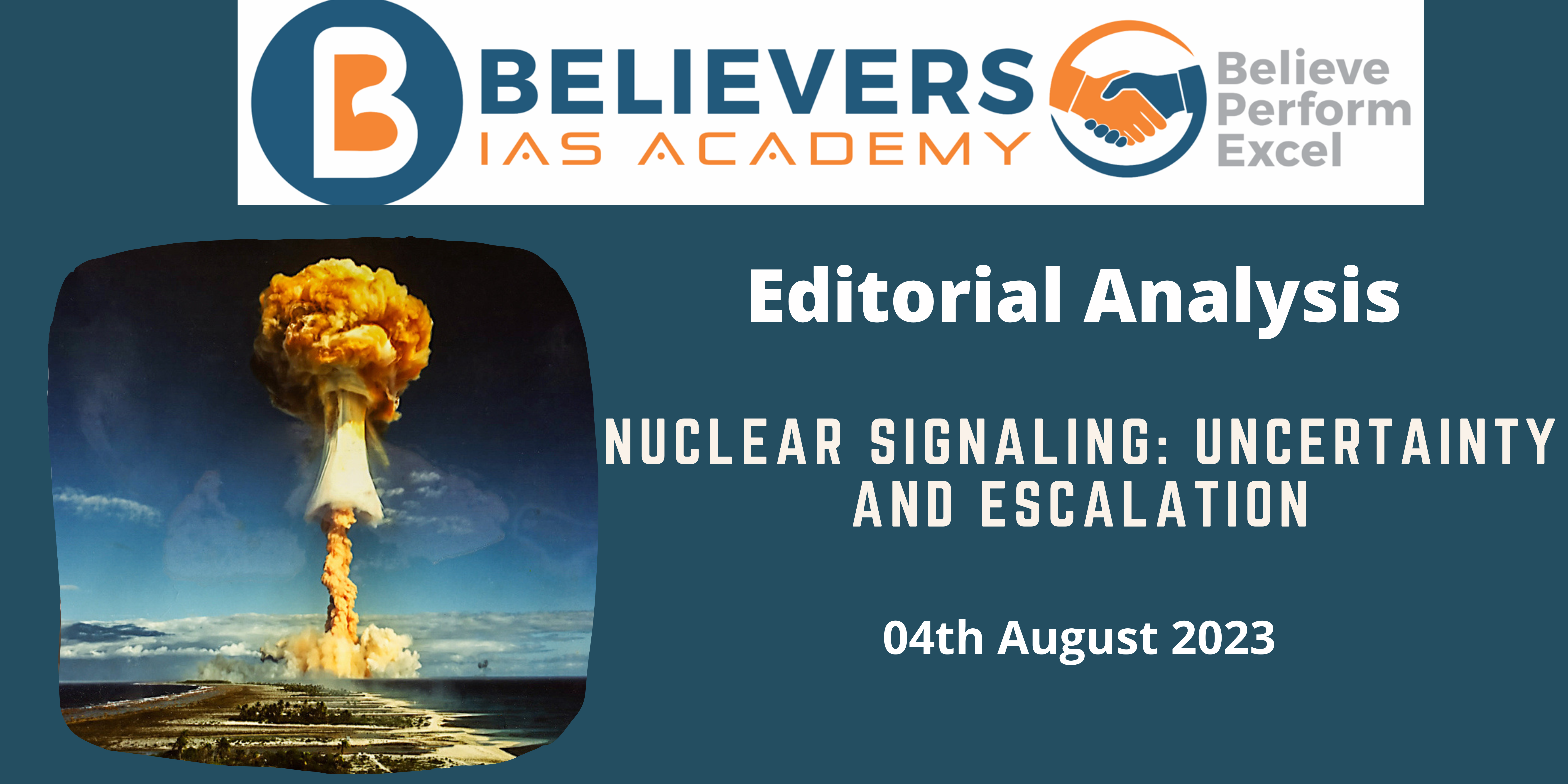Nuclear Signaling: Uncertainty and Escalation
Context:
In the world of nuclear powers, the recent conflict in Ukraine and the resurgent nuclear rhetoric have ignited concerns about managing nuclear escalation between major nations. The once dormant United States-Russia nuclear rivalry is now rearing its head, presenting perplexing challenges in a transformed political landscape.
Relevance:
GS – 01 (Mineral & Energy Resources)
GS – 03 (Nuclear Technology)
Prelims:
- Nuclear Power Corporation of India Limited (NPCIL)
- National Thermal Power Corporation Limited (NTPC)
- Indian Oil Corporation Limited (IOCL)
- Non-Proliferation Treaty (NPT).
Mains Question:
- Discuss the factors contributing to deterrence failure and the evolving landscape of nuclear escalation management between major nuclear powers in the context of recent events in Ukraine. 250 words
Dimensions of the Article:
- Deterrence Failure: The Echoes of Ineffective Signaling
- The Grey Zone: Probing Red Lines and Uncertain Responses
- Escalation and Risk: The conflict of Nuclear Deterrence
- Redefining Sovereignty: Ukraine and the Fuzzy Lines
- Uncertain Thresholds and Ambiguity
Deterrence Failure: The Echoes of Ineffective Signaling
- The meeting between U.S. President Joe Biden and Russian President Vladimir Putin in Geneva underscored the urgency of nuclear arms control.
- Attempts to dissuade Russia from its aggressive stance through diplomatic overtures and stern warnings proved futile.
- As the Russian military operation unfolded in Ukraine, the world witnessed the inadequacy of traditional deterrence measures in today’s political climate.
The Grey Zone: Probing Red Lines and Uncertain Responses
- Both the U.S. and Russia find themselves operating in an ambiguous realm, where nuclear rhetoric oscillates between caution and belligerence.
- The cold war era, marked by proxy wars in distant lands, no longer provides a blueprint for managing escalation between the two nuclear behemoths.
- In this murky terrain, the concept of deterrence confronts new challenges, necessitating a fresh perspective on escalation management.
Escalation and Risk: The Conundrum of Nuclear Deterrence
- Thomas Schelling’s pivotal work on nuclear deterrence during the 1960s and 1970s elucidated the concept’s intricacies. He highlighted that while nuclear weapons may be unusable, they possess political utility in preventing conflicts between nuclear powers.
- Schelling’s analysis of uncertainty and risk, akin to a calculated game of probabilities, aimed to induce rationality among adversaries. Raising the stakes through escalation while leaving some aspects to chance was crucial to ensuring credible deterrence.
Redefining Sovereignty: Ukraine and the Fuzzy Lines
- Russia’s nuclear doctrine emphasizes two scenarios for nuclear weapon use: responding to nuclear or mass destruction weapon usage against it or its allies, and countering aggression that jeopardizes the very existence of the state.
- The blurring of sovereignty between Russia and Ukraine complicates the situation, with Russia perceiving the latter as an extension of its own interests.
- Furthermore, the escalate-to-deescalate approach, relying on tactical nuclear weapons, challenges the U.S.’s commitment to controlled conflict escalation.
Uncertain Thresholds and Ambiguity
- The evolving geopolitical landscape in the wake of the Ukraine conflict has engendered uncertainty in Russia’s military objectives and red lines.
- The cautious calibration of weapon supply to Ukraine by the U.S., along with continuous probing of Russian responses, highlights the importance of adapting to Russia’s shifting thresholds.
- In this context, loss aversion, as explored by Daniel Kahneman and Amos Tversky, assumes significance, urging nations to refrain from doubling down on poor choices.
Way Forward:
Navigating the complexities of nuclear signaling in today’s political environment necessitates a reevaluation of traditional escalation management strategies. The absence of clear-cut red lines and the asymmetric nature of U.S.-Russia relations demand the formulation of new guard rails to preserve the nuclear taboo and prevent unintended escalations.
Conclusion:
The resurgence of nuclear tensions between major powers demands introspection on the limitations of traditional deterrence and escalation management. As the world grapples with the uncertainties of nuclear signaling and confronts the erosion of historical norms, the imperative for fresh approaches to nuclear stability and peace becomes undeniable. Adapting to this evolving landscape will be pivotal in ensuring the preservation of global security and averting the catastrophic consequences of uncontrolled nuclear escalation.





